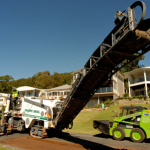Functions Of The Road Profilers. The road profilers which are used heavily today are capable to perform various functions such as: asphalt profiling, patching, leveling, pavement removal, texturing, edge planing, trenching, shoulder rehabilitation, excavation, milling, cross slope leveling, in-situ stabilization, concrete profiling, rubber removal etc.
Asphalt Profiling. The pavement profiling operation provides one economical solution for restoring rough pavements by removing materials. When new material is needed, the asphalt profiler cuts away the ruts and the bumps and new less costly overlay is inserted on the surface. The asphalt profiler eliminates the need for regulation, differential compaction or thick leveling. The new overlay will last longer.

Leveling. A pavement profiler is used when various ruts, bumps and other fatty areas need to be removed form the surface. The surface that has been cleaned from bumps or rust has improved bonding areas. The new overlay which is placed on the surface compacts evenly and creates a monolithic bond. This profiling operation is generally used on acceleration and breaking areas at road intersections.
Patching. Road profilers are powerful machines capable to remove areas of distressed pavement as a preparation for road repairs. Thanks to the upward cutting operation provided by the road profilers, no damage is caused to the underlying pavement during the profiling action. This way, the costs for saw cutting and the need for backhoe are eliminated. The materials that have been excavated are loaded on dump trucks for later usage as a base for other pavement projects.
Removal Of Pavement. Increased clearance on the surface can be achieved with road profilers by removing the pavement area where there is a lower clearance bridge. By removing the old layers, the original design and specifications of the surface can be restored once again.
Edge Planing. The kerb height lost can be a big problem, especially if there is a buildup of asphalt overlays. As a solution, a road profiler can be used to remove the excess asphalt overlays so that new asphalt layer can be inserted with existing kerb or channel. During this operation, the deteriorated pavement needs to be removed and thrown away.
Texturing. The texturing technique is generally used as a bonding method on airport runways and taxiways, and also in areas with increased rubber build up. This technique is also implemented when skid resistant surface on sharp bends needs to be created. Different texturing patterns can be created using different types of road profilers. The texturing patterns can be created by increasing the speed of the road profiler or by increasing the lateral spacing.
Trenching. Road profilers are also effective when trenching action is required. Longitudinal, block and other cracks are some of the problems that can be eliminated with the road profilers. A pavement profiler is used to cut out the cracks to a sufficient depth so that a membrane strip can be inserted over the cracks, and then the cracks are filled with new layer of asphalt. This technique is heavily used for treatment of cracks in asphalt layers. This way there is no need for a special trenching machine and the cost is reduced.


